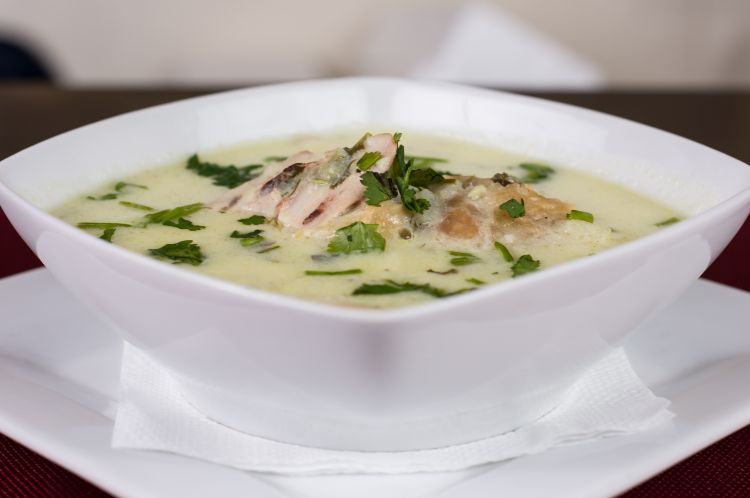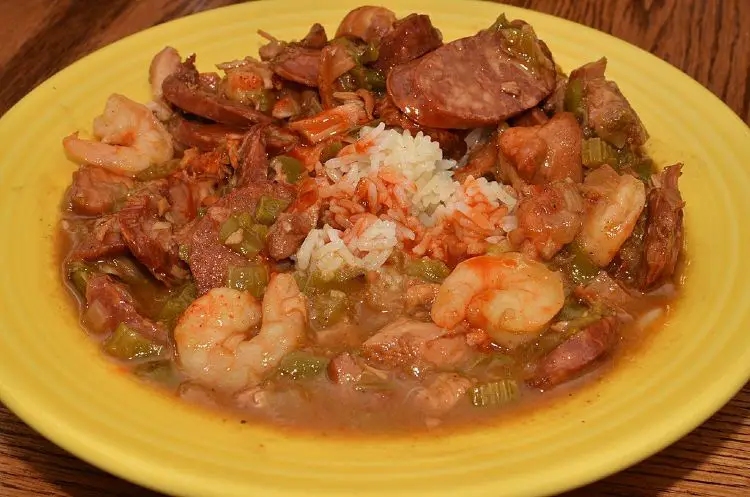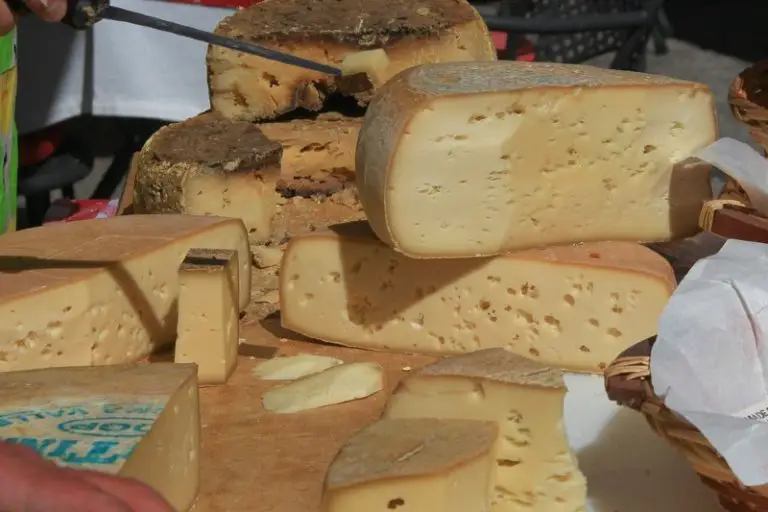Tom Jaine, Editor of Prospect Books
As I am standing in Tom Jaine’s kitchen, talking to his wife Sally, she tells me that they have lived in this Devon house for thirty years and found it quite by chance as they were driving around the area. I can well believe it because its handsome front facade hangs on the edge of a precipice in a magical wooded valley west of Dartmouth, so isolated and quiet all you can hear is birdsong and the gentle rustle of trees laden with spring blossom. It feels as if you are miles from anywhere, in a secluded hamlet approached only by a dirt track flanked by tall native hedges.
I am aching to take photographs to show The Foodie Bugle followers on Twitter, because all around me are the most beautiful plates, cups, glasses and pots, the inheritance of several generations of a family for whom the kitchen and dining room are the beating heart of the home. It would take even the keenest collector the wealth of Croesus and the life span of Methuselah to accrue such wonderful things. Methinks it might just be too rude to insist.
We are waiting for Tom to come inside from the garden. I clutch my notebook, in which I have a photocopy of what Tamasin Day-Lewis wrote in The Telegraph over a decade ago about Prospect Books, the food and cookery book publishing imprint that Tom owns and runs.
“I urge you, if you have a real interest in the subject {of food}, to subscribe to the following catalogues for wonderful and original presents for yourself and others. Tom Jaine’s facsimile, historical and ethnic cook books published by Prospect Books are peerless. Nowhere is the opaque clarified better than in the historical cookery book. The food of other cultures and traditions, and of our past, is our social history, as rich and succulent as a braised oxtail.”
When he arrives, we descend the steps into the lower ground floor of the house. This is Tom’s study, the Prospect HQ office where he runs the book publishing house he bought from Alan Davidson in 1993, when Alan needed to complete his magnum opus, “The Oxford Companion to Food”. It is a compact room, made even smaller because every conceivable inch of wall, desk and even floor space is covered with beautiful, old books. I could move in as his assistant quite happily, I could make the tea, bake the biscuits and fill envelopes.
Prospect Books is a micro publisher, publishing only around four to eight books every year, a number so small one has to wonder how it stays alive. The business was originally founded thirty two years ago, and to this day is the only publisher in Britain which singularly focuses on the history, culture and ethnology of food. In addition Tom is also the publisher of Petit Propos Culinaires, A5 size journals about food studies and history, with three editions published per year since 1980.
Everything that is produced from this perfectionist stable is beautiful, well researched, scholastic and thoughtful. The catalogue of works is of great interest to the modern day cooks who want to delve into the past in order to illuminate and understand the origins, identity and meaning of contemporary food, farming and cookery. Some of the books are facsimiles of ancient texts from writers such as Giacomo Castelvetro, Apicius, Cato, Palladius and Archestratus, whilst others focus on English cookery, techniques, recipes and regional foods.
In “The Road to Vindaloo: Curry Cook and Curry Books” David Burnett and Helen Saberi trace the development of Anglo Indian cookery from 18th Century to the modern day. In “Rhubarbaria” Mary Prior has researched the origins of this plant to Asia, Siberia, Mongolia and the foothills of the Himalayas, whilst “Realm of Fig and Quince” by Ria Loohuizen looks at the history and recipes of two of the most enticing late summer fruits.William Ellis’s “The Country Housewife’s Family Companion of 1750” is an 18th-century book that discusses the diet, farming, medicine and household of ordinary English people. In the 95th edition of the PPC booklet I can read about “The hidden recipes of Bartolomeo Sacchi” by David Waldon and “The death of Rotted Barley” by Charles Perry. There are also some very interesting book reviews at the back, including one of Clarissa Dickson Wright’s “A History of English Food” published by Random House.
You could peruse the shelves for hours, lost in wonder and astonishment, in this civilised and scholarly world, ensconced in Tom’s time worn leather armchair. You could not find a more interesting library outside of the world’s top Universities.
The practical ramifications and commercial imperatives that underpin running a higher brow publishing business today are anything but genteel, however. Whenever a new author contacts Tom, his initial stance is always to inject a note of cold reality into their aspirations.
“Prospect Books is a very small publishing business: for me a bestseller, like “Building a Wood Fired Oven” or “Honey from a Weed”, sells in four figures, not in five or six figures like a big publishing house. Many of my books sell in their hundreds, whereas a big publishing house will sell a book in tens of thousands of copies. I operate at the margins of a very competitive market. I do not include colour photography because I do not have the capital required to create big, glossy hardbacks. But what I can offer is the fact that I work very hard so that by publishing your work with Prospect Books you can get yourself on the ladder, establish yourself as an author and from there other publishers may want to work with you. Then you may be able to achieve larger sales and make more money.”
Sally Butcher, of “Veggiestan” fame {published by Pavilion, an imprint of Anova Books}, did just that, starting her writing career with “Persia in Peckham” published by Prospect. Then there are authors one would imagine to be mainstream and commercially saleable, such as Caroline Conran, whose “Under the sun” French cookery book was published by Pavilion in 2002, and who has moved to the Prospect stable with “Le Sud de France: the food and cooking of the Languedoc”.
“Cooking and Dining in Medieval England” written by Peter Brears, a world authority on the subject, was picked up by the committee for the Andre Simon Award in 2009, who awarded it “Food Book of the Year”. The aforementioned “Honey from a Weed” by Patience Gray was chosen by Rick Stein as the book that most influenced his outlook on Mediterranean cookery. From cooking testicles to understanding tripe and making trifle {whose origins can be traced way back to 1596!}, Prospect publishes books for discerning and curious cooks who search its arcane portfolio for enlightenment that cannot be found elsewhere.
Tom does all of the editing, proof reading, re-writing, designing and art work prior to publishing and works with two printing companies, one in Southampton and one in Malta. Authors are paid 10% of all the royalties but no advances. The marketing of books in the publishing world is notoriously cut throat, and it amazes me that this academic, scholastic man, from this solitary library in deepest, darkest English countryside can compete in such an ungentlemanly world.
“Publishing has changed beyond recognition. The media is now so much noisier. Marketing for a book has to be done a very long time before publishing. After a book is published the book shops and the PRs and the reviewers are not interested anymore, all the excitement is beforehand. Bookshops now are very resistant to your approaches, so all the sales are done through wholesale reps, such as Bertrams and Gardners. Each rep will have a portfolio of at least 30 or 40 publishers. So it’s very hard to get that rep to sell a book with the same enthusiasm with which it was commissioned, written and published.”
Of course, running The Foodie Bugle, and being active on social media, I know exactly what goes on behind the scenes of a cookbook launch. Weeks before publication date publishers’ PR departments are busy rallying influential bloggers, galvanising the attention of online magazines, engaging with editors of print magazines and rounding up Tweeters with high follower numbers by sending them books, inviting them to lunch or tea, or even a pop-up supper club in the author’s home. Pre-launch cocktail parties are organised, where A and B list celebrities and bloggers get to mingle with the literary agents, journalists, publishers and PR agents that have systematically trampoline-hyped that author to the highest position possible in the rankings. Amazon reviews, Tweets, Facebook likes and Pinterest shared cover photographs are bartered for free cookery demonstrations and maybe even introductions to more influential people, and onwards and upwards the slippery spiral of reciprocal oozing and schmoozing goes.
I doubt very much indeed that the erudite Mr. Tom Jaine has anything to do with this strange, shallow and uncouth charade. His upbringing and career have not prepared him for this brave, cynical new world.
Born in 1943, he studied Modern History at Balliol College and worked as an archivist before becoming a restaurateur. He ran The Carved Angel in Dartmouth with Joyce Molyneux for ten years, organised the Oxford Symposium on Food and Drink for four years, was Editor of The Good Food Guide for five years and won umpteen awards for his food writing, published in all the broadsheet national newspapers and leading magazines. He also built a wood fired oven in his back courtyard, wrote a book about it and held bread baking courses. There is no doubt that were he starting out today, PPC would probably be a Blog, the Prospect Portfolio would be on an Expression Engine website with full colour, Photoshopped, professional stylised photography and he would be active on all the media channels that are now necessary to sell copies, lobby attention and influence buyers and reviewers.
He has never bought another food magazine’s mailing list in order to bump up sales of his journal, nor does he socialise or network with other food writers or publishers. He gardens, bakes bread and works prodigiously, as well as travelling to all the international and domestic bookfairs. Looking out of his office window into his peaceful, organic garden it is so easy to understand how far on the perimeter fringe Prospect stands, and yet how important and valuable the brand and everything it stands for.
We sat to have lunch with his wife, one of their four daughters and one of their sons-in-law, a chef. As we ate, Tom regaled us with stories of other writers who inhabit this landscape and take themselves terribly seriously and the academics that bore him senseless. “They are such hard work. So tiring, so boring!” he exclaims. One moment he is a curmudgeonly Victor Meldrew and the next he is laughing like a public school boy who has just told a rude joke, slapping his thigh and tucking into his chocolate brownie with gusto.
I ask him what it was like to work with the legendary Alan Davidson, whose 900 page encyclopedic “Oxford Companion to Food” informs and inspires every single food writer I know, starting at aardvark and ending at zuppa inglese, leaving no stone unturned in between. Tom edited the second edition in 2006, the one I refer to for all my work.
“Alan was a very nice man, a perfect gentleman. He dreamed of putting things into systems, into bulleted lists. It took him twenty years to complete the book because he kept being distracted by the work of Prospect Books and by PPC. In the end the writing of the book, all the notes and reference manuals were transferred to a separate flat across the road from where he lived. Jancis Robinson wrote the “Oxford Companion to Wine” in only five years because she was much more organised about it. Alan was never part of the elite, academic world and neither am I. He was awarded the Erasmus prize for his work, the highest accolade, which he was very proud of. He had a heart attack in 1993, I took over Prospect and PPC and he died in 2003. I have kept it all going since then.”
The most poignant moment of the visit for me was when he took me outside to see the various outbuildings and barns he uses to store all the old copies of Prospect books. There are literally scores of boxes of them in rows upon rows, sitting in sepulchral darkness. Some he sells online, others at the symposiums {that run both in Oxford and Leeds}. I kept thinking those books should not be on those shelves: they should be in schools, in libraries, in homes, in book clubs and on the shelves of cookery schools, National Trust gift shops and bookshops up and down the land.
The problem with having an older website, no Blog and no popular websites writing actively about your work is that Google does not drive traffic to your business nor does it rank it high up the listings, in a world where search engine optimisation is the holy grail of all marketing endeavour. As I photograph some of the beautiful covers there is no doubt in my mind that Tom Jaine’s work deserves far greater public acclaim and recognition.
I finish the Tamasin Day-Lewis article and its rallying cry after the long return home from my visit. In it she writes lucidly:
“No Arts Council grant has been forthcoming to the valiant and valuable Prospect Books. What does it say about our country, that we are not enabling someone whose driving passion, appreciation, and deep understanding of food scholarship is unparalleled to flourish? If this slim volume of an enterprise should cease to exist, we will lose something priceless. Not elite and narrow, but fundamental, a utility, a slice of history that should exist for future generations.”
It’s in our hands: we can help Prospect Books survive and flourish by participating, engaging and promoting its new issues. I very much hope that this article has sparked your interest.
Contact Details
Prospect Books: www.prospectbooks.co.uk
Follow Tom Jaine on Twitter: @ProspectBooks




